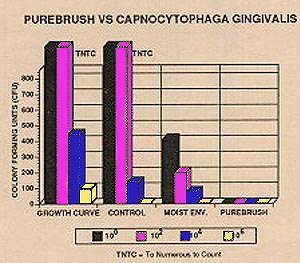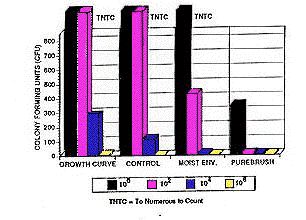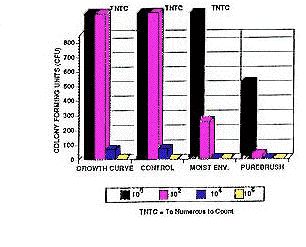Clinical Studies
Effectiveness of an Ultra-Violet light toothbrush sanitizer on three micoorganisms
ABSTRACT
Over the last twelve
years in the study and treatment of oral inflammatory diseases,
the role of the toothbrush has gained importance as a major
transmission factor. Efforts have been made to find a biologically
sound toothbrush and to identify effective ways of sanitizing
toothbrushes. The objective of this study was to evaluate
an ultra-violet (UV) light, daily-use toothbrush sanitizer
against the criteria of the Food and Drug Administration's
(FDA) requirement for sanitization (e.g. 102
reduction of microorganisms). Twelve sterile clear toothbrushes
were used for each microorganism . Candida albicans, Beta-Hemolytic
Streptococci, and Capnocytophaga gingivalis were used to
inoculate the study toothbrushes. Two toothbrushes per microorganism
were plated immediately after inoculation as controls; five
toothbrushes per microorganism were placed in a humid bacteriological
hood to simulate a bathroom environment, and five toothbrushes
per microorganism were place in the UV light sanitizer.
All toothbrushes were sonicated in and plated on appropriate
media; colony forming units (CFU) were counted after 24
and 48 hours. A minimum of 1x102-4 CFU reduction
of microorganisms was observed with the UV treated toothbrushes
inoculated with Candida albicans and Beta-Hemolytic Streptococci
as compared to moist environment and control toothbrushes.
No Capnocytophaga was observed on the UV treated toothbrushes,
while 3.0X106 CFU of Capnocytophaga were observed
on the moist environment toothbrushes. The Purbrush UV
Light Toothbrush Sanitizer was found to be effective in
eliminating or in reducing the numbers of microorganisms
found on the toothbrushes after only 24 hours. This
study was supported by summer student/mentor program of
the J. Dean Robertson Society.
MATERIALS AND METHODS
To achieve
the above objective, growth curves for each of the microorganisms
were observed. The growth curves were determined by streaking known
dilutions of microorganisms on Blood agar, Sabouraud Agar and Laked
Blood Agar at dilutions of 1x102, 1x104, and
1x106. The rates of growth for 24 and 48 hours at 37C
were recorded. The plates were streaked in duplicate and the number
of colony forming units (CFU) were recorded for the two plates and
averaged to reduce the possibility of skewed
data.
Twelve Oral B two row clear
toothbrushes were sterilized using ethylene oxide and were
contaminated by immersing each toothbrush in a known concentration
of a microorganism for ten minutes. The toothbrushes were tapped to
remove excess liquid. Two toothbrushes were sonicated and plated
immediately as controls. Five toothbrushes were placed in the moist
environment for 24 hours.
All
toothbrushes were sonicated in 5 ml of the appropriate broth for one
minute to recover the microorganisms (Todd hewitt Broth for
Beta-Hemoloytic streptococci, Sabouraud Broth 4% for Candida
albicans, Brain Heart Infusion Broth for Capnocytophaga species).
The recovery media was streaked on plates in duplicate to determine
the number of CFU at dilutions of 102, 104, 106. One colony from
each plate was gram stained to certify the microorganisms were those
listed.
RESULTS The results of the study are summarized in the following graphs:

PUREBRUSH
VS BETA-HEMOLYTIC STREPTOCOCCI

PUREBRUSH VS CANDIDA
ALBICANS
Featured Articles
Read MoreCustomer Testimonials
-
- "Purebrush provides the protection they need..."
- "Because people forget to change their toothbrushes as often as they should, Purebrush provides the protection they need."
-
- "Dr visits have decreased dramatically..."
- Purebrush is wonderful! I have two small children and our doctor visits have decreased dramatically since we purchased our Purebrush. I really think your product is great and I believe that you are doing a great thing for people's health.
Read More




